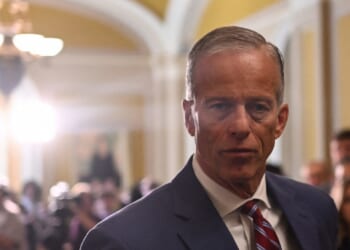California residents are facing the potential of massive gas price increases, according to two recent studies.
The state’s gas prices could rise by up to 75% by the end of 2026, according to a report released Monday by Michael Mische, an associate professor at the University of Southern California’s Marshall School of Business. Moreover, the planned shutdown of the Phillips 66 oil refinery complex in Los Angeles alongside Valero’s planned closure of its refinery in Benicia could potentially lead to a 21% reduction in California’s refining output from 2023 to April 2026, according to the report.
“Based on current demand and consumption assumptions and estimates, the potential consequences of the Phillips 66 refinery closure scheduled for October 2025, the estimated average consumer price of regular gasoline in California could potentially increase by as much as 33.6% from the April 23, 2025, price of $4.816 to $6.045 to $6.433 a gallon by calendar year end 2025,” Mische wrote in his report. “We can expect retail prices to be even higher in counties such as Mono and Humboldt.”
Republican California state Senate Minority Leader Brian Jones sent a letter Tuesday calling for Democratic California Gov. Gavin Newsom to prevent further refinery closures in his state, citing concerns such as job stability and “risks to fuel prices.”
“I am writing to express deep concern about the announced closures of the Phillips 66 refinery in Los Angeles by the end of 2025 and the Valero refinery in Benicia by April 2026,” Jones wrote. “These two facilities produce approximately 20% of California’s in-state gasoline supply. Their loss poses serious risks to fuel prices, job stability, and the state’s long-term energy security. We must act swiftly to avoid a future where supply falls short and families across the state are left paying the price.”
Similarly, Californian households could pay an additional cost of roughly 74 cents per gallon of gas if the state’s Legislature extends a cap-and-trade program — which is set to expire in 2030 — that limits greenhouse gas (GHG) emissions, according to a report released Wednesday by California’s Legislative Analyst’s Office.
The projected higher gas costs would be “particularly burdensome for lower-income households as they tend to spend a relatively high share of their incomes on transportation fuels compared to wealthier households,” according to the report.
California’s cap-and-trade program requires natural gas power plants, coal power plants and other companies to purchase allowances to offset emissions, according to the U.S. Energy Information Administration. The program “establishes a declining limit on major sources” of GHG emissions throughout the state and also “creates a powerful economic incentive for polluters to invest in cleaner, more efficient technologies and energy,” per the California Air Resources Board.
“Just last month, the Governor directed the state to redouble efforts to work with refiners to ensure a safe, affordable and reliable supply of gasoline,” Daniel Villasenor, a spokesperson for Newsom, said in a statement shared with the Daily Caller News Foundation. “In the two years since the Governor signed California’s gas price gouging law, the state has avoided severe gasoline price spikes like the historic 2022 spike, saving Californians billions of dollars at the pump. The law established the nation’s first state-level independent petroleum watchdog to hold Big Oil accountable, and the state has more transparency from the industry than ever before. Governor Newsom will keep fighting to protect Californians from price spikes at the pump.”
A Newsom spokesperson told the DCNF that Mische’s study does not back up his primary claim about the future rise of gas prices, maintaining that the professor cited vague data and did not adequately show his work.
The spokesperson added that Mische “failed to acknowledge the possibility that lost in-state production could be supplied through other means … ignored that markets respond to price … and ignored that the current gasoline refining market is not competitive, and the exercise of market power likely drives price increases.”
All republished articles must include our logo, our reporter’s byline and their DCNF affiliation. For any questions about our guidelines or partnering with us, please contact [email protected].
DONATE TO BIZPAC REVIEW
Please help us! If you are fed up with letting radical big tech execs, phony fact-checkers, tyrannical liberals and a lying mainstream media have unprecedented power over your news please consider making a donation to BPR to help us fight them. Now is the time. Truth has never been more critical!
Success! Thank you for donating. Please share BPR content to help combat the lies.
We have no tolerance for comments containing violence, racism, profanity, vulgarity, doxing, or discourteous behavior. If a comment is spam, instead of replying to it please click the ∨ icon below and to the right of that comment. Thank you for partnering with us to maintain fruitful conversation.




![Trump Posts Hilarious Pope Meme, Leftists Immediately Melt Down [WATCH]](https://www.right2024.com/wp-content/uploads/2025/05/Trump-Posts-Hilarious-Pope-Meme-Leftists-Immediately-Melt-Down-WATCH-350x250.jpg)
![‘It’s a Recipe for a Hundred Years of National Dominance’: Stephen Miller [WATCH]](https://www.right2024.com/wp-content/uploads/2025/05/Stephen-Miller-Completely-Obliterates-CNN-Host-Over-Her-Illegal-Immigration-350x250.jpg)

![Pentagon Begins Booting Trans Troops After Supreme Court Greenlights Ban [WATCH]](https://www.right2024.com/wp-content/uploads/2025/05/Pentagon-Begins-Booting-Trans-Troops-After-Supreme-Court-Greenlights-Ban-350x250.jpg)








